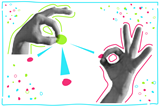Students discuss the topic differently when simulations replace practicals. So let’s investigate which offers the best learning outcomes
Laboratory practicals allow students to experience chemical phenomena first hand. However, they cost money and time, with questionable impact on learning. Lab teaching generally focuses on the macroscopic domain. Students observe the outcomes of experimental work, even if they are often not truly experimenting. However, the explanations that underpin the observed outcomes lie mainly in the sub-microscopic domain, while communication of the outcomes normally uses the symbolic domain. The ability to navigate the different domains is critical to student success, and this takes additional time outside of the lab practical.

To probe how useful practicals remain today when compared to the latest teaching technologies, Amy Phelps and co-workers compared a hands-on activity with a computer simulation. The activities focused on electrochemistry, which is often cited by teachers as a difficult subject to teach and to learn.
The researchers analysed how macroscopic and particulate representations influence student interactions. Nine pairs of students participated in a simulated particulate visualisation (PV) activity. Another nine pairs completed a traditional hands-on practical, the macroscopic visualisation (MV) activity. The activities were based on classic electrochemistry practicals involving combinations of M/Mx+ half-cells. The researchers analysed transcribed audio and video recordings of students’ discussions to identify patterns.
The researchers analysed how macroscopic and particulate representations influence student interactions. Nine pairs of students participated in a simulated particulate visualisation (PV) activity; find the simulation here: bit.ly/2kAONKI. Another nine pairs completed a traditional hands-on practical, the macroscopic visualisation (MV) activity. The activities were based on classic electrochemistry practicals involving combinations of M/Mx+ half-cells. The researchers analysed transcribed audio and video recordings of students’ discussions to identify patterns.
Different discussions
The team found that MV students spent more time in the laboratory than the PV students – 127 minutes versus 89. The students completing the MV activity also spent more time talking to instructors – 33, rather than 17 minutes. The PV students spent a higher proportion of their time talking to peers, although the overall time spent by both groups was similar at around 59 minutes.
However, analysis of the peer-to-peer conversations showed a stark difference in the nature of the discourse. The PV students spent 52 minutes discussing the experiment’s results, but the MV students only talked about them for 18. This was partly because the MV students had to discuss and carry out experimental procedures.
A key difference was the lack of conceptual discussion between MV students compared to PV students. However, the students’ comments indicated that the PV students exhibited a number of misconceptions, not all of which were reflected in marks on the assessment.
One notable misconception was that electrodes get smaller because the ions formed during oxidation have a smaller radius than the atoms from which they are formed, rather than the fact that the resulting ions dissolve in the solution. Revealing the nature of these student conversations is valuable in informing our knowledge of students’ misconceptions and how they are formed. Such knowledge is key for developing pedagogical content knowledge, which underpins effective chemistry teaching.
There is no question that the hands-on practical activity still has an important role to play in education. Not only do students develop valuable technical and manipulative skills, but they also experience ‘wow!’ moments that motivate them – this study found that the MV students were more excited about their findings. However, the analysis also shows that students have a different, and potentially more valuable, conversation when presented with particulate representations of the same phenomena. Nonetheless, it is a concern that the conversations can exacerbate misconceptions if students are left to their own devices.
Teaching tips
Help students to make connections between the macroscopic and sub-microscopic by augmenting hands-on practical activities with appropriate particulate representations. Simulations and animations can be an effective way of moving students’ conversations towards conceptual matters. The authors indicate they are investigating this combined approach.
It is difficult for teachers to listen to all students’ conversations, meaning that misconceptions can be propagated. To avoid this, provide scaffolding prompts that steer conversations in the right direction. Ask students to share aspects of their discussion afterwards, allowing assessment both by their peers and the teacher.
Your role in selecting activities and guiding discussions is vital to ensure that students grasp the underpinning principles. While we may wish to promote independent learning inside and outside the classroom, students can easily take wrong turns when discussing concepts freely with peers. Be mindful of this and provide opportunities to challenge and eradicate misconceptions.
References
V Hunter, I Hawkins and A J Phelps, Chem. Educ. Res. Pract., 2019, DOI: 10.1039/c9rp00064j














No comments yet